Hang Snatch Exercise: How To, Benefits & Variations
Author:
Unlock your full potential by engaging with our experts and community! Have questions about your fitness journey or looking for expert advice on weightlifting techniques? Don’t hesitate — leave a comment below and Oleksiy Torokhtiy will provide a personalized answer and insights to help you reach your goals.
Torokhtiy is reader-supported. Some links are affiliate links, and we may earn a commission at no extra cost to you. See our disclosure page for details.
If you’re looking to mix up your routine, hang snatch is a great choice for both beginners and those with some (or a lot of) experience. It’s an impressive lift and it might look intimidating, but we have a whole bunch of tips and explanations on how to do it.
Mastering the form, understanding benefits, mistakes to avoid… We have it all and more!
And if you get bored of it – no worries, we also have some variations for you. We’ll keep it clear and simple, so grab your barbell (and some water because you’ll need it!) and let’s see how to hang snatch!
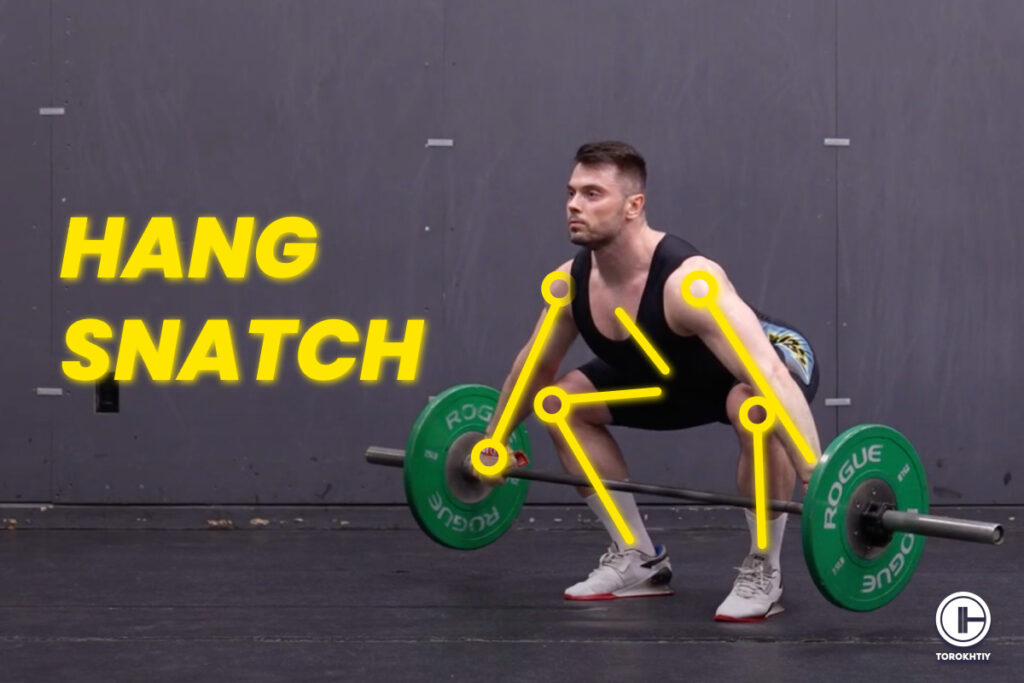
What is the Hang Snatch?
Mistaking this exercise for the traditional snatch is a common blooper. We’re actually looking at two different exercises.
With the traditional snatch, the barbell starts on the ground, and the hang snatch starts with the barbell hanging just below your knees (low hang) or just above your knees (high hang). You can even start the movement standing tall and straight with the barbell at your thighs/mid-thighs, but then you lower the barbell just below the knees for the low-hang, or just above the knees for the high-hang.
This kind of starting position makes the lift simpler, so if you’re a beginner, you’ll find the hang snatch easier to do than the snatch. If you’re advanced, though, you’ll still benefit from it because it will help you refine your technique, work on a turnover speed and more.
Hang snatch’s main purpose is to develop explosive power. It engages multiple muscle groups, like legs, hips, core, and shoulders. This explosive movement does a great job at translating into many other sports and activities and it can help your performance in anything that needs quick, powerful movements.
Another great thing about the hang snatch is that it will help improve your coordination, balance, and flexibility because it relies on super precise timing and control, otherwise you can’t do it correctly.
Generally, it’s a versatile, really effective exercise that will do wonders for both strength and power, as well as for your functional fitness.
Save it for easy access!
Bookmark this page now to access the program and instructional videos anytime, anywhere.
Stop wasting time searching during your gym sessions.
How to Do the Hang Snatch?
It’s a move that seems tricky at first, but don’t be scared – once we break it down in steps, you’ll see it’s simpler than you think. Not simple, mind you, just simpler.
Ready to learn how to master the hang snatch technique?
1. Starting Position
First things first – the setup. You’ll start by standing with your feet shoulder-width apart. Hold the barbell with a wide, hook grip, and palms facing your thighs.
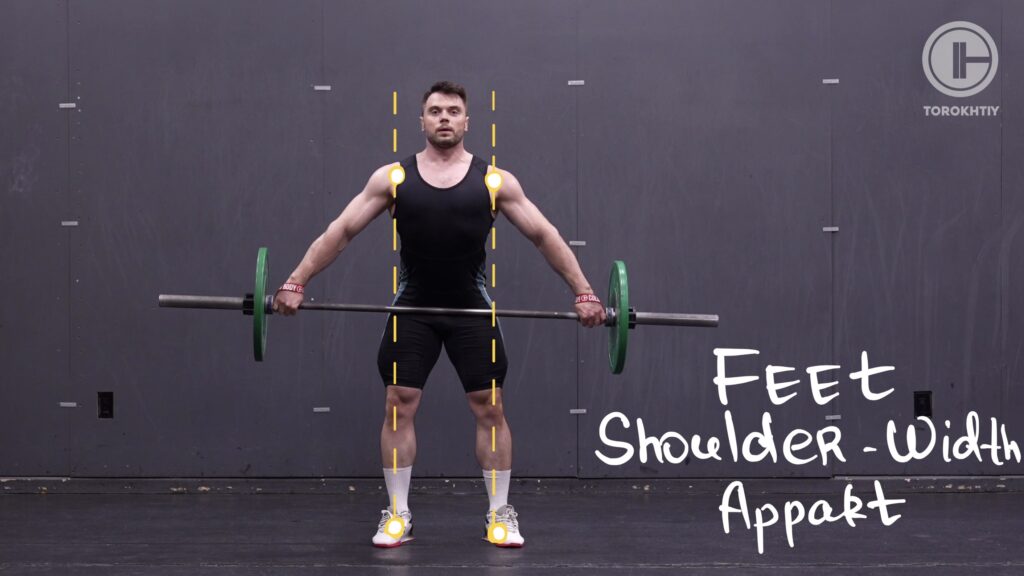
The barbell should be below the knee level for the low hang snatch or at about mid-thigh for the high hang snatch.
Bend your knees a little and push your hips back to lower the barbell just above your knees. Keep your chest up, your back straight, and eyes looking forward.
This is how you’ll start your lift.
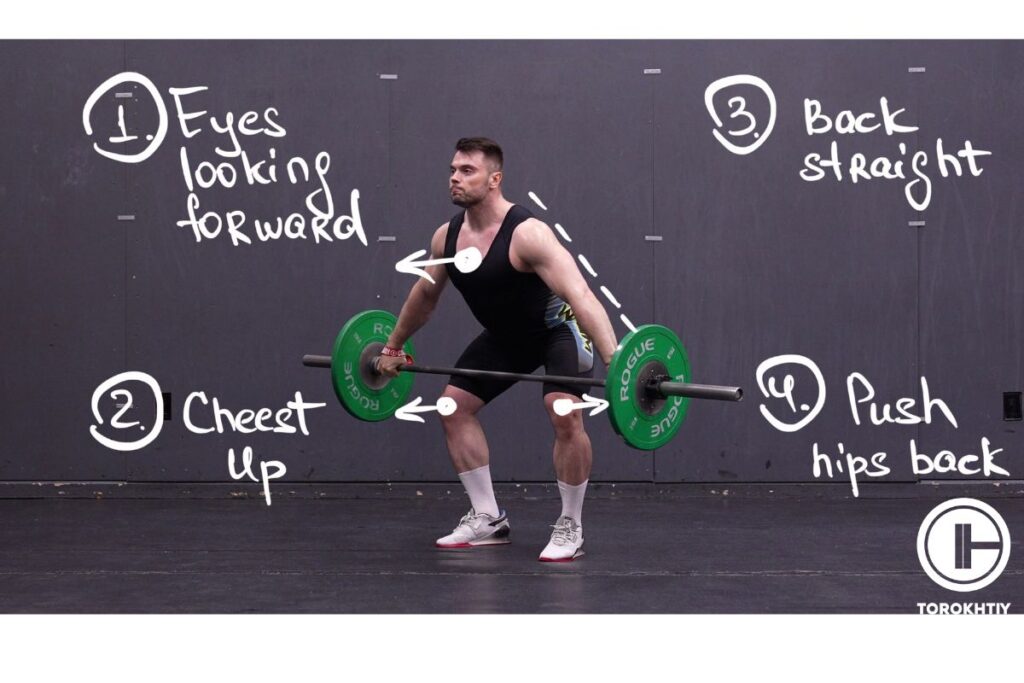
2. First Pull
There’s no actual first pull since this is the hang version. You start either with a high or low hang.
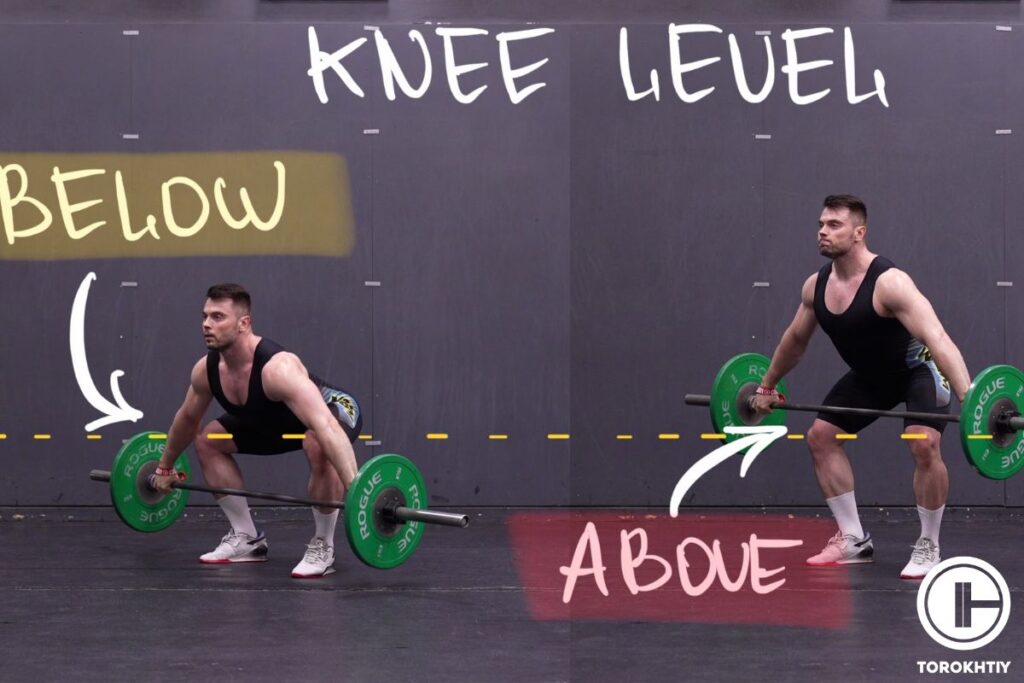
3. Second Pull and Power Position
Now, going from the starting position, extend your hips and knees to start the actual lift. This needs to be a powerful, but really controlled movement and the barbell needs to move vertically in a straight line close to your body.
As the bar gets to the power position, increase your speed and keep pulling the bar up while staying on the balls of your feet. Your shoulders should start to shrug as you prepare for the next explosive phase.
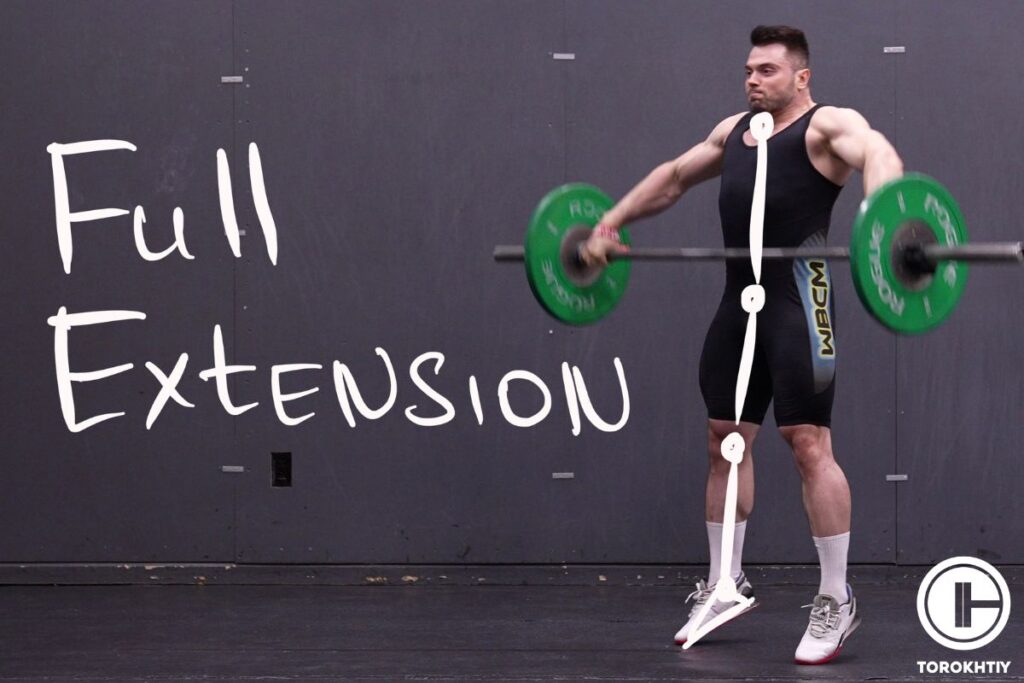
4. Turnover and Catch
This is the explosive part of your lift. Extend your hips and knees fully and jump a little off the ground. As you do this, pull the barbell up with your arms (keep it close to your body!).
As the bar reaches chest height, rotate your wrists to get your elbows under the bar and catch it overhead with your arms fully extended. At the same time, bend your knees and hips and drop into a squat.
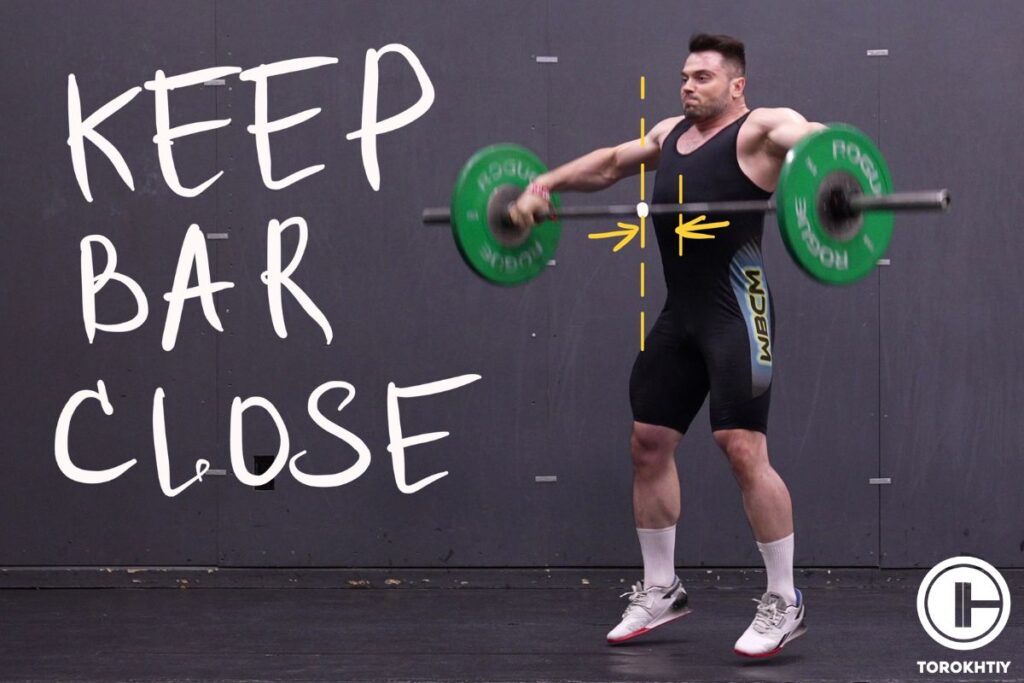
5. Recovery
Once you’ve caught the bar over your head, extend your hips and knees and stand up. Keep the barbell over your head, keep your arms fully extended, and make sure you’re stable and balanced.
Lower the bar carefully back to where you started from by just doing the movement in reverse. Make sure to do this in a controlled way and with good posture. And that’s it! Congrats, you’ve done a hang snatch!
Follow us!

Free!
Get a 2-week Weightlifting Program as a bonus for the subscription to kickstart your training plan!

Free!
A Simple Hang Snatch Program
The hang snatch can do a lot in terms of improving your strength and power, but you need a clear plan to include it into your routine. Here’s how to do that:
1. Beginners
Start with light weights:
- Use just the barbell or add minimal weight plates
- Make sure the weight is comfortable and not distracting
Sets and Reps:
- Do 3-4 sets of 3-5 reps
- Focus on maintaining proper form rather than lifting heavy
Form and Technique:
- Start from the hang position,
- Keep your back straight, core engaged, and shoulders over the bar
- Drive through the hips and pull the bar over your head in one smooth motion
2. Intermediate/ Advanced
Use Heavier Weights:
- Aim for weights that are 60-80% of your 1RM
Sets and Reps:
- Do 3-5 sets of 2-3 reps
Form and Technique:
- Concentrate on the speed of the pull and the transition under the bar
- Include accessory exercises like high pulls to improve specific aspects of the lift
Recovery:
- Make sure to rest for 2-3 minutes between sets to maintain performance
3. Progression
Master the Basics
- Start with light weights and protect your form
Increase the Weight Gradually
- Once you’re comfortable with the technique, start increasing the weight in small increments
Number of Sets and Reps
- As you progress, adjust the number of sets and reps to match intensity, your strength and skill level
Variations
- Add variations like the hang power snatch or snatch balances to challenge your technique and strength even more
5 Common Hang Snatch Mistakes
As with every other exercise, you need attention to detail and proper form to be able to do it correctly. Good form is what makes the exercise effective and it protects you from injuries.
Let’s see what are some common mistakes people make, so you’re aware of them.
Tips From the Champ
Focus on maintaining a strong and stable core throughout the lift to ensure proper form and avoid injury. Keep in mind that heavy hang snatch requires longer recovery of the back & hamstrings.
Olympic Weightlifting Champion
1. Not Warming Up
You should always start your workout with a warm-up because this prepares your body for the exercises you’ll be doing. Do 5-10 minutes of dynamic stretches and mobility exercises; your body will thank you for it. Definitely perform a few adaptive sets as well to make sure form is there.
2. Poor Starting Position
If you start with an incorrect posture, it will throw off the entire lift. Make sure your feet are shoulder-width apart, that your chest is up, shoulders over the bar and that your back is straight.
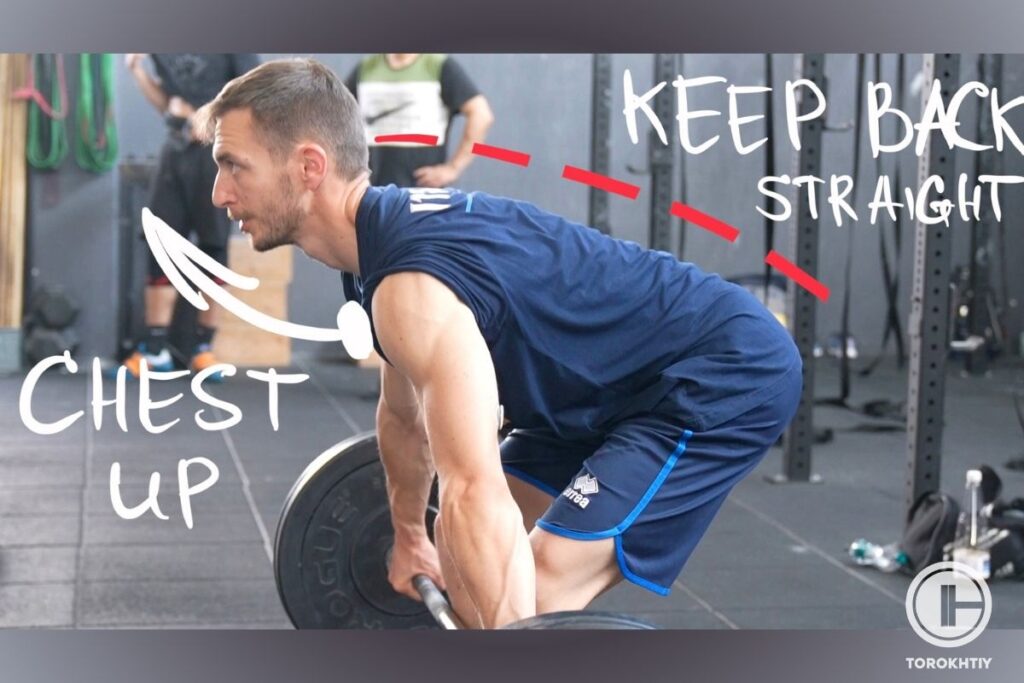
3. Lifting with the Arms
One of the biggest mistakes you can make is to use your arms to lift the barbell. You should rely on the explosive power of your hips and legs instead.
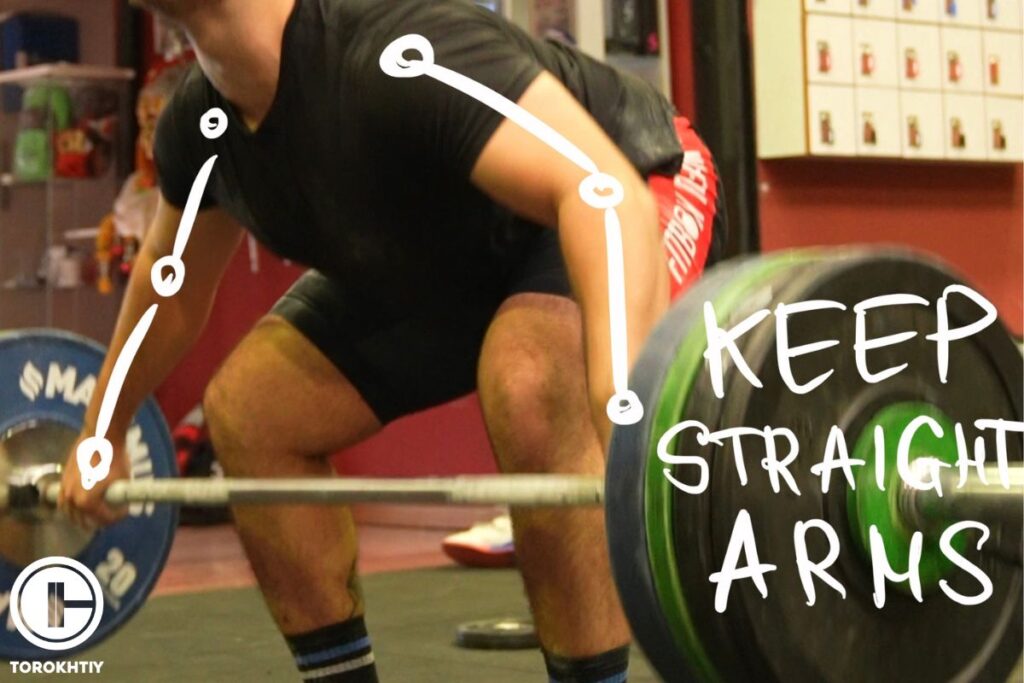
4. Not Staying Close to the Bar
Do not allow the bar to drift away from your body because you’ll lose control of it and your lift will be messed up. Keep it close and make sure it travels in a straight, vertical path.
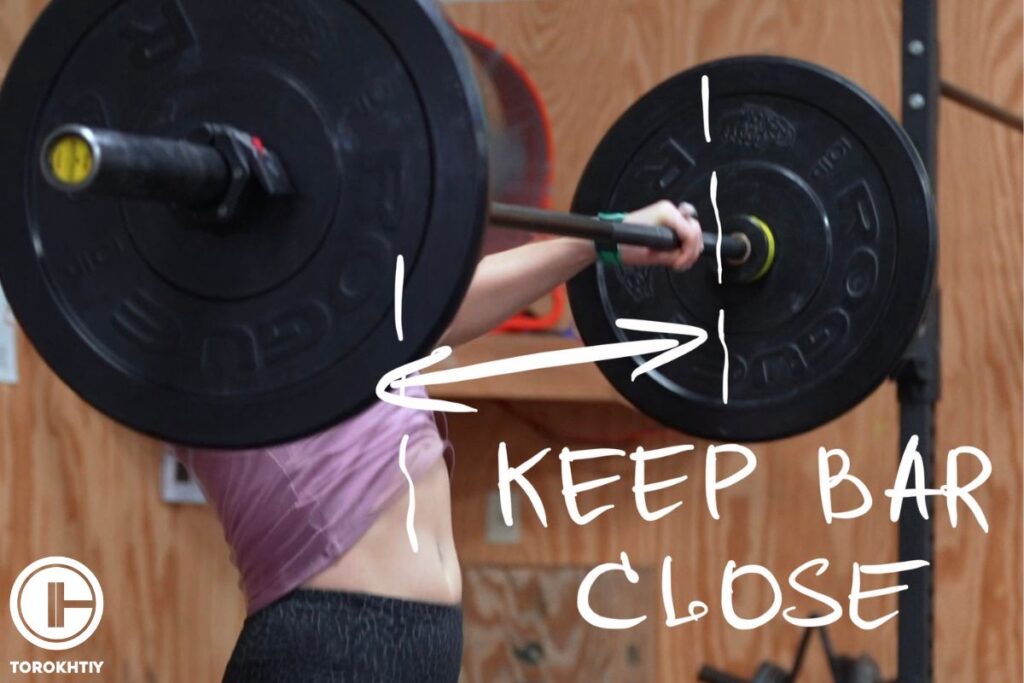
5. Insufficient Hip Extension
If you don’t extend your hips fully, it will reduce the power of your lift. You should explosively drive your hips forward and extend them completely before pulling the bar up.
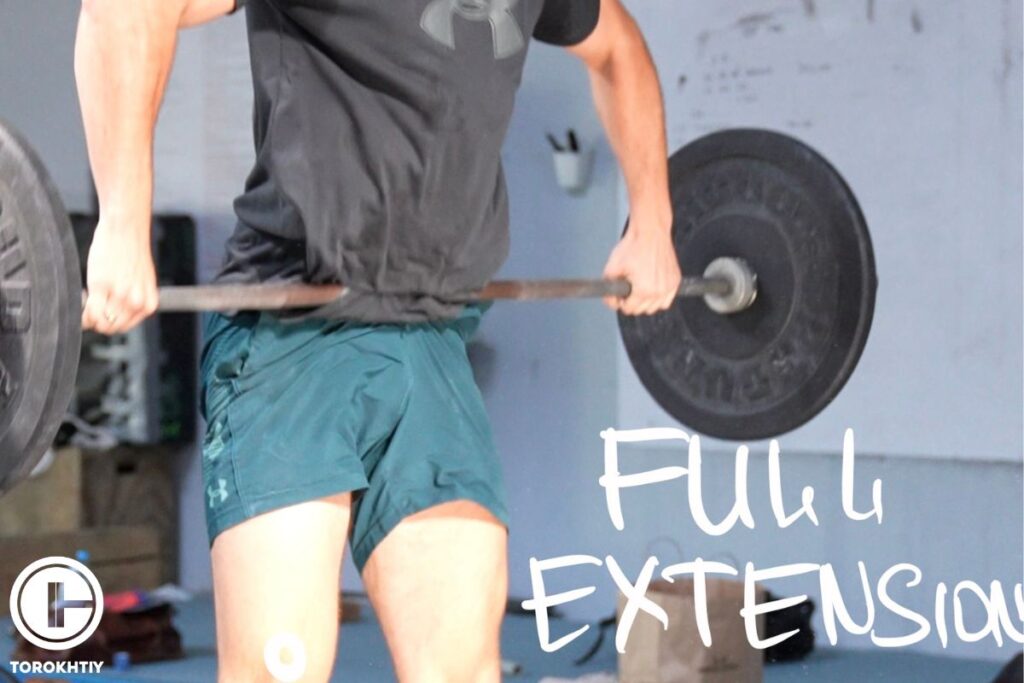
5 Benefits of Hang Snatch
The hang snatch is an impressive move and once you really master it, you’ll feel great when you show it off at the gym. But that’s not its purpose, it’s just a cool bonus.
There are a lot of hang snatch benefits that will positively affect your health and fitness.
✅ Better Explosive Power
This is an exercise that’s excellent for developing explosive power. It needs quick, forceful extensions of the hips, knees, and ankles, so it trains your body to generate max force in a short amount of time.
Explosive strength is very beneficial for all kinds of sports and activities and rely on quick, powerful movements.
✅ Improved Coordination and Balance
If you’ve ever tried to do this, you know the amount of coordination and balance you need. If you haven’t, let’s just say it’s a lot.
The hang snatch forces you to sync your lower and upper body while maintaining stability, and this will result in better coordination and balance.
✅ Builds Full-Body Strength
The hang snatch engages a lot of different muscle groups, and when you work all of these muscles at the same time, it will help you build overall strength and muscle mass.
✅ Increased Flexibility and Mobility
You need a wide range of motion to do the hang snatch, especially in your shoulders, hips, and ankles. Over time, it will do a lot in terms of your mobility and flexibility, which is important for preventing injuries and having good posture.
✅ Stronger Core
Core stabilizes your body during the entire hang snatch, and since it’s continuously engaged, it gets stronger the more you exercise. A strong core is very important for your strength in general, as well as for stability and preventing injuries.
2 Hang Snatch Variations
The hang snatch is excellent by itself, but there are some variations you can add to target different muscle groups. Let’s see what those are.
1. Low Hang Snatch
This one starts with the barbell hanging just below the knees and it focuses more on the explosive hip extension and timing. It’s a great way to develop power and speed off the floor.
2. High Hang Snatch
For this one, you’ll start with the barbell at hip level or a little bit higher. This variation allows for a more extended pull and focuses more on the explosive second pull phase of the lift. It’s great if you want to improve barbell trajectory and timing.
5 Hang Snatch Alternatives
If variations aren’t enough and you want more of a difference, then alternative exercises will work like a charm!
1. Power Clean
This exercise focuses on explosive hip and knee extension to lift the barbell from the floor to the shoulders. It’s similar to the hang snatch in the sense that it also develops power, speed, coordination, and full-body strength.
2. Dumbbell Snatch
The dumbbell snatch is a unilateral exercise that involves lifting a dumbbell from the floor to a position over your head in one fluid motion. It targets similar muscle groups like the hang snatch, but it gives you more stability and control.
3. Single-Arm Kettlebell Snatch
This one focuses mostly on your posterior chain, meaning hamstrings, glutes, and lower back, but it engages your shoulders and core, too. You swing a kettlebell between your legs and then extend the hips to propel it overhead in one smooth motion.
It develops explosive power and improves coordination and stability.
4. Hang Snatch Pull
The hang snatch pull will strengthen your lifting mechanics but without the overhead component. You pull the barbell from the hang position to chest level using explosive hip extension and shrugging motion.
5. Hang Clean
Hang clean starts from the hang position (usually above the knees) and explosively extend your hips, knees, and ankles to pull the bar up. As the bar reaches its peak, you quickly drop into a full squat to catch the bar on your shoulders and then stand up.
It builds explosive power, coordination, and strength.
Who Should Do Hang Snatch?
If you’ve peeked at the benefits of the hang snatch, you’ve probably come to the conclusion that this is an exercise pretty much everyone can benefit from. But it has different benefits for different groups of people, so let’s get into more detail on that.
1. Beginner Athletes
If you’re just starting out with a sport, the hang snatch will help you understand the basics of explosive movements. It will also do a great job at developing coordination and strength, as well as confidence in lifting and handling weights.
2. Advanced Athletes
If you know what you’re doing and you’re no longer a beginner, the hang snatch will improve your explosive power and speed, which is really important for high-level performance. It will refine your technique and it will be easier for you to do complex movements.
3. Weightlifters
The hang snatch is important for mastering the snatch lift, which is a key component of Olympic weightlifting. Apart from focusing on the critical phases of the snatch (second pull and turnover), it also builds explosive strength.
4. Functional Training Athletes
This is an exercise you can easily include in functional fitness routines to boost the efficiency of your workout. The hang snatch will improve functional fitness, agility, and coordination.
5. Fitness Enthusiasts
The hang snatch works multiple muscle groups at the same time, so it’s time-effective. It can do wonders for muscular endurance, improve metabolic rate, and help you build strength in your entire body.
6. Athletes in Other Sports
It’s a very useful exercise for any sport that needs explosive power and quick movements, like basketball, football, and track and field. It will improve power output, rate of force and speed, which means – better performance.
Muscles Worked by the Hang Snatch
Why should you care? Well, it’s good to know which muscles you’re developing. If you’re lifting weight, you probably want to work on how your muscles look, so it makes sense to know what to expect from a workout and which muscles get the most attention.
The quads play a big role in this exercise. They help you extend your knees when you rise from the squat position during the initial pull and the final catch phases. The hamstrings are included, too, because they’re key for bending the knees and extending the hips.
Your glutes are crucial for hip extension, and your calves kick in during the jump phase to help extend your ankles and contribute to the lift’s vertical motion.
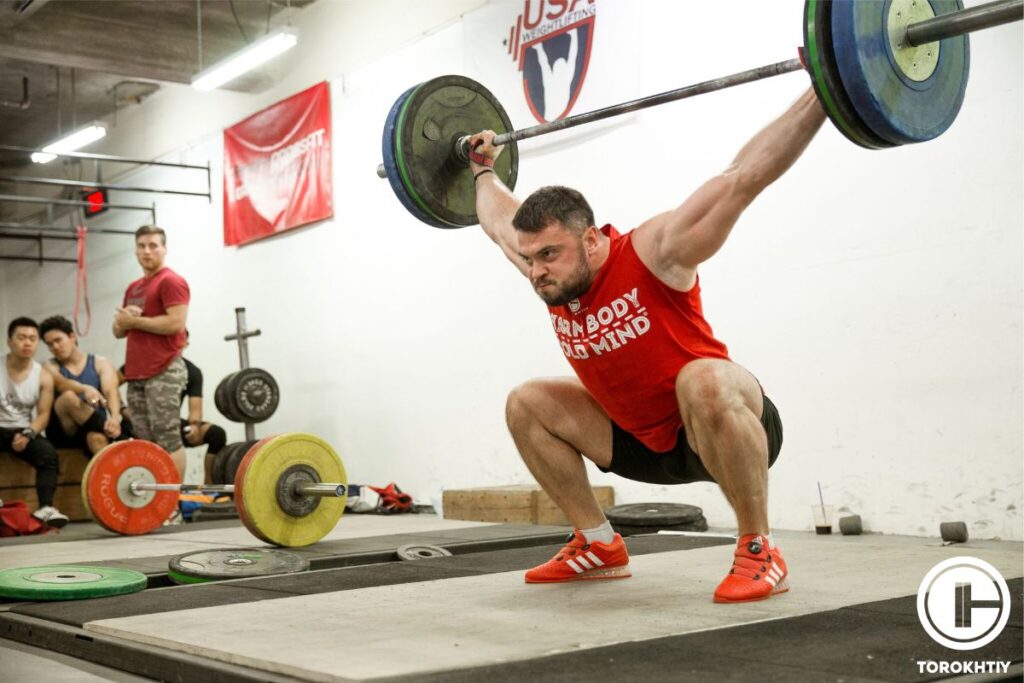
And we can’t forget about the core! It’s what keeps you stable during the lift, and it helps with your posture. The stronger the core, the easier it is for you to keep your torso upright, plus it can reduce the risk of some injuries.
Your shoulders are engaged as well, especially the deltoid muscles, because they help you lift and stabilize the bar overhead during the catch phase. And lastly, the traps, in upper back, are engaged during the shrugging motion.
The posterior chain is another big player in the hang snatch. Holding the bar in the starting position requires a strong isometric hold, which contributes a lot to posterior chain development. This includes the lower back, which helps maintain a stable and strong position during the lift, prevents rounding of the spine and ensures proper form.
Conclusion
If you’re looking to perfect the snatch, then opting for the hang snatch might be a solid starting point (once you’ve covered the basics).
In order to get the best results in the snatch, you’ll need explosive power; and the hang snatch will provide you with that.
Have you done the hang snatch before; if yes — what was your goal? Hang snatch vs power snatch — which one do you prefer and why?
Anything we’ve missed? Or perhaps you have some extra questions; be sure to leave your thoughts in the comments section below!
Hang in there and happy snatching!
Also Read:
- Hang Snatch High Pull
- Snatch High Pull
- Muscle Snatch vs Power Snatch vs Snatch
- Hang Muscle Snatch Exercise
- Snatch High Pull
- Power Snatch
References:
- Health Promotion Board (HPB) “Prevent Injuries with Proper Form During Workouts,” Singapore University Health Center, https://www.nus.edu.sg/uhc/articles/details/prevent-injuries-with-proper-form-during-workouts (accessed June 7th, 2024)
- Hyoung-Kil Park, Min-Kyung Jung, Eunkyung Park, Chang-Young Lee, Yong-Seok Jee, Denny Eun, Jun-Youl Cha, and Jaehyun Yoo. “The effect of warm-ups with stretching on the isokinetic moments of collegiate men.” Journal of Exercise Rehabilitation 14, no. 1 (2018): 78–82.
- Mayo Clinic Staff, “Weight training: Do’s and don’ts of proper technique,” Mayo Clinic, https://www.mayoclinic.org/healthy-lifestyle/fitness/in-depth/weight-training/art-20045842 (accessed June 7th, 2024)
- Michael H. Stone, Meg Stone, Erick A. Coetzee, Gunter Schwarz, Maren Gad, Jennifer Bertz, Chad M. Kerksick, Mark A. Kilgore, Kyle T. Mckinley, Jason P. Cole. “Exploring The Power Clean.” International Journal of Strength and Conditioning. 2020 Dec; 1(1): 1-17.
- Photos by Torokhtiy Media Team.
Why Trust Us?
With over 20 years in Olympic weightlifting, strength training, nutrition coaching, and general fitness our team does its best to provide the audience with ultimate support and meet the needs and requirements of advanced athletes and professional lifters, as well as people who strive to open new opportunities and develop their physical capabilities with us.
By trusting the recommendations of our certified experts in coaching, nutrition, and sports training programming, as well as scientific consultants, and physiotherapists, we provide you with thorough, well-considered, and scientifically proven content. All the information given in the articles concerning workout programming, separate exercises, and athletic performance, in general, is based on verified data.
The product testing process is described in more detail here.
Author: Oleksiy Torokhtiy
Olympic Weightlifting Champion
Best Results: Snatch – 200 kg,
C&J – 240 kg
Oleksiy Torokhtiy is a professional athlete boasting 20 years of experience in Olympic weightlifting. With multiple European and World titles under his belt, he has showcased his prowess in two Olympic Games (Beijing 2008 and London 2012). Upon concluding his illustrious career, Oleksiy dedicated himself to coaching. By 2022, he had conducted over 200 weightlifting seminars worldwide. He is the visionary behind an international sportswear and accessories brand known for its motto, “Warm Body Cold Mind.” Additionally, he is an esteemed author and the creator of a series of training programs and eBooks.



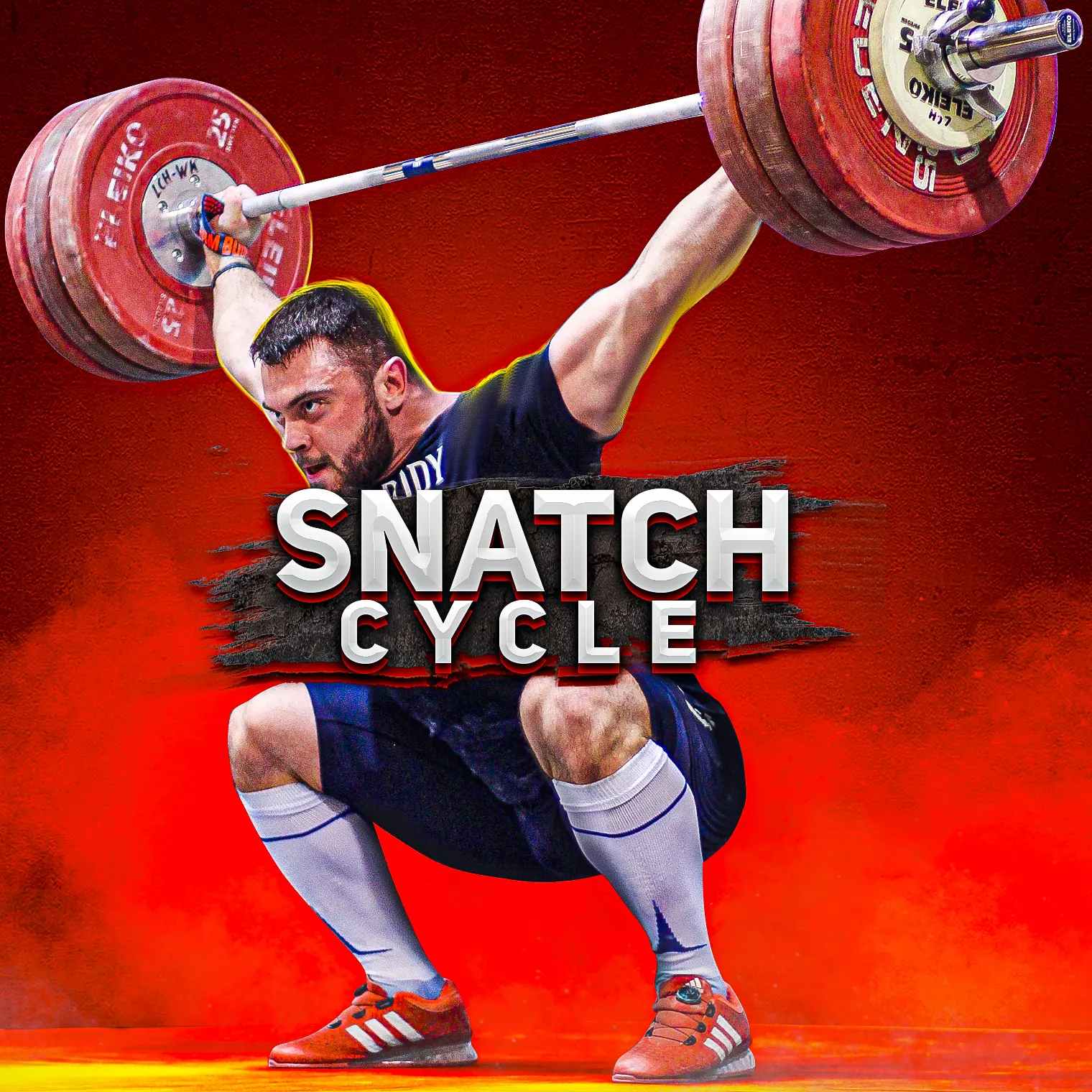

Still have questions after reading our article? Unlock your full potential by engaging with our experts and community! Don’t hesitate — leave a comment below and Oleksiy Torokhtiy will provide a personalized answer and insights to help you reach your goals.